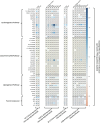Cross-Sectional Associations between Prenatal Per- and Poly-Fluoroalkyl Substances and Bioactive Lipids in Three Environmental Influences on Child Health Outcomes (ECHO) Cohorts
- PMID: 38691655
- PMCID: PMC11097396
- DOI: 10.1021/acs.est.4c00094
Cross-Sectional Associations between Prenatal Per- and Poly-Fluoroalkyl Substances and Bioactive Lipids in Three Environmental Influences on Child Health Outcomes (ECHO) Cohorts
Abstract
Prenatal per- and poly-fluoroalkyl substances (PFAS) exposure may influence gestational outcomes through bioactive lipids─metabolic and inflammation pathway indicators. We estimated associations between prenatal PFAS exposure and bioactive lipids, measuring 12 serum PFAS and 50 plasma bioactive lipids in 414 pregnant women (median 17.4 weeks' gestation) from three Environmental influences on Child Health Outcomes Program cohorts. Pairwise association estimates across cohorts were obtained through linear mixed models and meta-analysis, adjusting the former for false discovery rates. Associations between the PFAS mixture and bioactive lipids were estimated using quantile g-computation. Pairwise analyses revealed bioactive lipid levels associated with PFDeA, PFNA, PFOA, and PFUdA (p < 0.05) across three enzymatic pathways (cyclooxygenase, cytochrome p450, lipoxygenase) in at least one combined cohort analysis, and PFOA and PFUdA (q < 0.2) in one linear mixed model. The strongest signature revealed doubling in PFOA corresponding with PGD2 (cyclooxygenase pathway; +24.3%, 95% CI: 7.3-43.9%) in the combined cohort. Mixture analysis revealed nine positive associations across all pathways with the PFAS mixture, the strongest signature indicating a quartile increase in the PFAS mixture associated with PGD2 (+34%, 95% CI: 8-66%), primarily driven by PFOS. Bioactive lipids emerged as prenatal PFAS exposure biomarkers, deepening insights into PFAS' influence on pregnancy outcomes.
Keywords: PFAS; bioactive lipids; eicosanoids; inflammatory pathways; metabolic pathways; mixtures; pregnancy outcomes.
Conflict of interest statement
The authors declare no competing financial interest.
Figures


Update of
-
Cross-sectional associations between prenatal maternal per- and poly-fluoroalkyl substances and bioactive lipids in three Environmental influences on Child Health Outcomes (ECHO) cohorts.medRxiv [Preprint]. 2023 Nov 7:2023.11.03.23297930. doi: 10.1101/2023.11.03.23297930. medRxiv. 2023. Update in: Environ Sci Technol. 2024 May 14;58(19):8264-8277. doi: 10.1021/acs.est.4c00094. PMID: 37961525 Free PMC article. Updated. Preprint.
References
-
- Sunderland E. M.; Hu X. C.; Dassuncao C.; Tokranov A. K.; Wagner C. C.; Allen J. G. A Review of the Pathways of Human Exposure to Poly-and Perfluoroalkyl Substances (PFASs) and Present Understanding of Health Effects. J. Exposure Sci. Environ. Epidemiol. 2019, 29 (2), 131–147. 10.1038/s41370-018-0094-1. - DOI - PMC - PubMed
-
- Calafat A. M.; Wong L.-Y.; Kuklenyik Z.; Reidy J. A.; Needham L. L. Polyfluoroalkyl Chemicals in the US Population: Data from the National Health and Nutrition Examination Survey (NHANES) 2003–2004 and Comparisons with NHANES 1999–2000. Environ. Health Perspect. 2007, 115 (11), 1596–1602. 10.1289/ehp.10598. - DOI - PMC - PubMed
-
- Chiu W. A.; Lynch M. T.; Lay C. R.; Antezana A.; Malek P.; Sokolinski S.; Rogers R. D. Bayesian Estimation of Human Population Toxicokinetics of PFOA, PFOS, PFHxS, and PFNA from Studies of Contaminated Drinking Water. Environ. Health Perspect. 2022, 130 (12), 12700110.1289/EHP10103. - DOI - PMC - PubMed
-
- Fenton S. E.; Ducatman A.; Boobis A.; DeWitt J. C.; Lau C.; Ng C.; Smith J. S.; Roberts S. M. Per-and Polyfluoroalkyl Substance Toxicity and Human Health Review: Current State of Knowledge and Strategies for Informing Future Research. Environ. Toxicol. Chem. 2021, 40 (3), 606–630. 10.1002/etc.4890. - DOI - PMC - PubMed
-
- Calafat A. M.; Wong L.-Y.; Kuklenyik Z.; Reidy J. A.; Needham L. L. Polyfluoroalkyl Chemicals in the U.S. Population: Data from the National Health and Nutrition Examination Survey (NHANES) 2003–2004 and Comparisons with NHANES 1999–2000. Environ. Health Perspect. 2007, 115 (11), 1596–1602. 10.1289/ehp.10598. - DOI - PMC - PubMed
MeSH terms
Grants and funding
- U24 OD023382/OD/NIH HHS/United States
- P01 ES022841/ES/NIEHS NIH HHS/United States
- U2C OD023375/OD/NIH HHS/United States
- P30 DK089503/DK/NIDDK NIH HHS/United States
- U24 OD023319/OD/NIH HHS/United States
- P30 ES017885/ES/NIEHS NIH HHS/United States
- UH3 OD023251/OD/NIH HHS/United States
- P30 ES030284/ES/NIEHS NIH HHS/United States
- P30 ES019776/ES/NIEHS NIH HHS/United States
- P42 ES017198/ES/NIEHS NIH HHS/United States
- P50 ES026049/ES/NIEHS NIH HHS/United States
- P30 ES007048/ES/NIEHS NIH HHS/United States
- P30 ES010126/ES/NIEHS NIH HHS/United States
- P01 ES022848/ES/NIEHS NIH HHS/United States
- UH3 OD023272/OD/NIH HHS/United States

